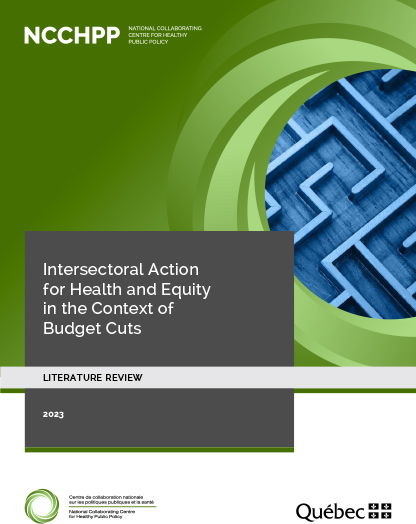Intersectoral Action for Health and Equity in the Context of Budget Cuts
This document is intended to provide relevant information to Canadian public health professionals and administrators, as well as to others who wish to undertake and sustain intersectoral activities fostering health and equity in the context of budget cuts. It outlines challenges, opportunities, and strategies to be considered when implementing or sustaining intersectoral action for health and equity in the context of budget cuts.
It is now well recognized in public health that intersectoral action is a relevant factor in ensuring that the missions of health prevention and promotion are carried out and that complex and multifactorial problems are addressed. In addition to the usual challenges associated with collaboration, actors wishing to implement or sustain intersectoral action are sometimes confronted with a significant issue, namely budget cuts. Because intersectoral action depends on adequate and stable funding and strong government support, periods of fiscal austerity, whether caused by economic or political circumstances, present challenges for this type of action. Given that periods of economic downturn reoccur cyclically and changes in political orientation are always a possibility, those wishing to initiate or sustain intersectoral action are bound to confront the reality of budget cuts sooner or later.
The National Collaborating Centre for Healthy Public Policy (NCCHPP) undertook to examine the challenges awaiting public health actors and others interested in implementing intersectoral action for health in the context of budget cuts. In addition, the opportunities that arise and the strategies for addressing the challenges or seizing the opportunities are considered. To accomplish this, the NCCHPP conducted a review of the scientific and grey literature published between 2000 and 2022. This analysis highlighted various challenges, opportunities and strategies, which are broadly associated with intersectoral action, but whose relevance is heightened when budgets are stretched.
Challenges
- Reliance on familiar solutions, risk aversion and withdrawl.
Opportunities
- Intersectoral action as a way to compensate for lack of resources: sharing risks, optimizing investments, controlling costs, avoiding duplication, doing things differently and innovating;
- An opportunity to counter the impact of budget cuts on health and equity.
Strategies
- Develop a shared vision and redouble advocacy efforts;
- Collaborate with adjacent sectors to minimize the impact of budget cuts on health and equity;
Create an environment that fosters collaborative innovation, to enable adaptation to the challenging context.


